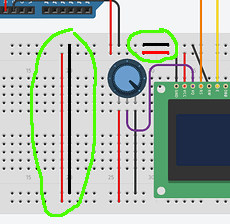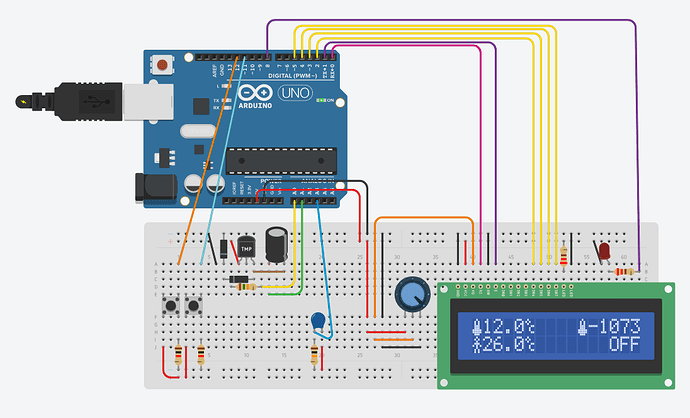could you tell me how to put a relay in this project on tinkercad? tell me the best cable and code for a relay according to the project I got from Internet. If you can also tell me if the circuit is right. telling me if all the components are needed.
The code of the project from Internet:
#include <Time.h>
#include <TimeLib.h>
#include <LiquidCrystal.h>
#define LM35pin 0 // connect LM35 Vout pin to arduino analog pin 0
#define LM35ref 1 // connect 2x 1N1418 diodes between LM35 ground pin and ground
#define thermistor_pin 3
#define btnPin1 11
#define btnPin2 12
#define relayPin 8
#define LCD_RS 2
#define LCD_EN 3
#define LCD_D4 4
#define LCD_D5 5
#define LCD_D6 6
#define LCD_D7 7
// initialize the library with the numbers of the interface pins
LiquidCrystal lcd(LCD_RS, LCD_EN, LCD_D4, LCD_D5, LCD_D6, LCD_D7);
String giorni[7] = {"Dom","Lun","Mar","Mer","Gio","Ven","Sab"};
float myTemp = 26.0;
int btnState1 = 0;
int lastBtnState1 = 0;
int btnState2 = 0;
int lastBtnState2 = 0;
byte iconTermo[8] = {
B00100,
B01010,
B01010,
B01110,
B01110,
B11111,
B11111,
B01110
};
byte iconDegree[8] = {
B01000,
B10100,
B01000,
B00011,
B00100,
B00100,
B00011,
B00000
};
byte iconMan[8] = {
B00100,
B01010,
B00100,
B01110,
B10101,
B00100,
B01010,
B01010
};
void setup()
{
setTime(23,31,0,10,5,18);
lcd.createChar(0, iconTermo);
lcd.createChar(1, iconDegree);
lcd.createChar(2, iconMan);
lcd.begin(16, 4);
pinMode(btnPin1, INPUT);
pinMode(btnPin2, INPUT);
pinMode(relayPin, OUTPUT);
}
void loop()
{
digitalClockDisplay();
// LM35
float temp2 = readLM35(true); // true = temp in celsius, false = temp in fahrenheit
lcd.setCursor(16, 0);
lcd.write((byte) 0);
lcd.print(temp2, 1);
lcd.write((byte) 1);
lcd.print(" ");
// thermistor
int sensorValue = analogRead(thermistor_pin);
float temp3 = Thermistor(sensorValue)/2;
float temp4 = round(temp3 * 2.0) / 2.0;
lcd.write((byte) 0);
lcd.print(temp4, 1);
lcd.write((byte) 1);
// ***** gestisco i pulsanti per regolare la temperatura *****
// pulsante più
btnState1 = digitalRead(btnPin1);
if (btnState1 != lastBtnState1)
{
if (btnState1 == HIGH)
{
// off => on
myTemp++;
}
}
lastBtnState1 = btnState1;
// pulsante meno
btnState2 = digitalRead(btnPin2);
if (btnState2 != lastBtnState2)
{
if (btnState2 == HIGH)
{
// off => on
myTemp--;
}
}
lastBtnState2 = btnState2;
// temperatura utente
lcd.setCursor(16,1);
lcd.write((byte) 2);
lcd.print(myTemp,1);
lcd.write((byte) 1);
lcd.print(" ");
if(myTemp<temp2)
{
// accendo la ventola
lcd.print("ON ");
digitalWrite(relayPin, LOW);
}
else
{
lcd.print("OFF");
digitalWrite(relayPin, HIGH);
}
delay(100);
}
/* Legge la temperatura */
float readLM35(boolean celsius)
{
int analogVal = 0;
for(int j = 0; j < 10; j++) // takes 10 samples to make sure we get a good value
{
analogVal += (analogRead(LM35pin) - analogRead(LM35ref)); // subtract Vout ADC reading from LM35 ground ADC reading
delay(10);
}
float tempC = (5 * analogVal * 10) / 1023;
if (celsius)
{
return tempC; // return temperature in degrees Celsius
}
else
{
return (tempC * 9 / 5) + 32; // return temperature in degrees Fahrenheit
}
}
double Thermistor(int RawADC)
{
double Temp;
Temp = log(((10240000/RawADC) - 10000));
Temp = 1 / (0.001129148 + (0.000234125 + (0.0000000876741 * Temp * Temp ))* Temp );
Temp = Temp - 273.15; // Convert Kelvin to Celsius
return Temp;
}
void digitalClockDisplay()
{
lcd.setCursor(0,0);
lcd.print( giorni[weekday()] );
lcd.print(" ");
lcd.print(day());
lcd.print("/");
lcd.print(month());
lcd.print("/");
lcd.print(year());
lcd.setCursor(0,1);
lcd.print(" ");
lcd.print(hour());
printDigits(minute());
printDigits(second());
}
void printDigits(int digits)
{
lcd.print(":");
if(digits < 10)
lcd.print('0');
lcd.print(digits);
}




